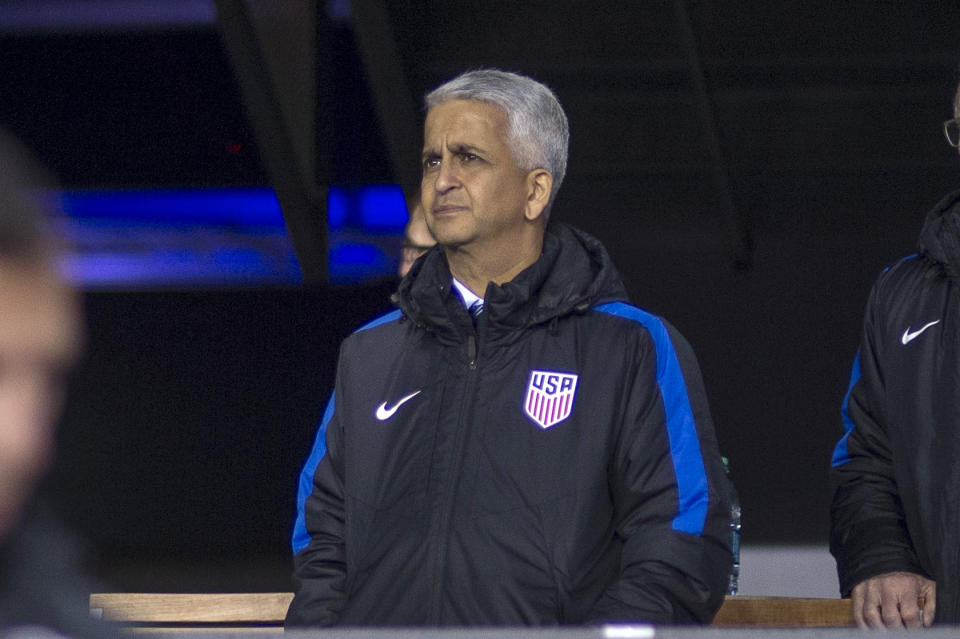The seven-man U.S. Soccer presidential race serves an important purpose

When Sunil Gulati ran for the U.S. Soccer Federation presidency for the first time in 2006, he did so unopposed. When he was re-elected in 2010 and 2014, his opposition was the same: non-existent. If he should run for a fourth term in early 2018, as he is still widely expected to do, Gulati will face, as things stand, no fewer than seven opponents.
That’s a good thing.
On Monday, NBC soccer analyst and former MLS and U.S. national team player Kyle Martino stepped into the suddenly crowded fray, just weeks after declaring that he wouldn’t be running because it didn’t make financial sense for his family. He joins Steve Gans, a lawyer; Paul Lapointe, an amateur soccer administrator; Eric Wynalda, a former national league star and current TV analyst; Michael Winograd, also a lawyer; Carlos Cordeiro, Gulati’s long-time ally and vice-president; and former national teamer Paul Caligiuri.
There’s a circular irony to Caligiuri’s inclusion. It was his late goal in Trinidad and Tobago in 1989 that saw the U.S. into the 1990 World Cup, beginning the ascendant modern era. It was also in Trinidad and Tobago that the Americans were unexpectedly denied qualification for the 2018 World Cup last month, bringing about the ongoing crisis and, thereafter, Caligiuri’s presidential candidacy.
Then, of course, there’s Gulati himself, who has come under enormous pressure after the men’s national team program stagnated and then regressed badly — just over a year after the women’s national team posted its worst-ever performance at a major tournament at the Rio Olympics.
If Gulati doesn’t run, it’s widely expected that all-time men’s national team leading scorer Landon Donovan will do so. It’s unclear why, exactly, or what their arrangement appears to be — if they have one.
This election is turning wacky, with the ambitious coming out of the woodwork as they sense opportunity. It’s got the feeling of the Republican primary race for the 2016 presidential election, with a crowded field and no obvious front-runner, making it a long-odds race for all candidates.
Should Gulati run, seeking to conserve his place at the head of U.S. Soccer to go with his coveted seat on the FIFA Council, he has an obvious advantage. The vote, after all, isn’t a public one. The constituency is one made up of members of youth, adult and pro councils, an athletes council, board members, life members and a fan representative. And Gulati has had a stranglehold on U.S. Soccer’s power structure for over a decade.
It’s hardly a fair fight. A loud segment of the fan base may badly want a change at the top — for the sake, if nothing else, of seeing some fresh ideas put into action — but the voters are largely the products of a federation meticulously built by Gulati. It will take an enormous upset to dethrone him, assuming he runs.
The other candidates, meanwhile, range from comically unqualified to merely dark horses. There’s no one obvious replacement for Gulati. Cordeiro seems to have obvious qualifications but would likely suffer from his close association to Gulati — he’s hardly a change candidate, after all. Martino and Wynalda are famous, smart and blessed with a platform, but neither has any administrative experience — let alone at the head of an organization with a reported nine figures in cash reserves. And the remainder of the field doesn’t appear to stand even the remotest of chances for a lack of even the above things.
But even if Gulati remains in power, as he likely will, going through this exercise is useful. Turning an uncontested formality into a real election not only offers the voters a choice, but it creates a record that he can be held to account for.
For once, Gulati, will have to take a stance on major matters that his actions will be held up against. During the course of campaigning, which he has carefully avoided thus far — publicly anyway — he’ll have to answer questions and make promises.
There’s little doubt that the federation has made enormous progress under Gulati. The broader question is whether it will keep progressing under him. And in order to ascertain that, making him apply for his long-time job in a public forum, with other competitors, is a productive exercise.
If Gulati really does have ideas to continue his life’s work, he’ll have to proclaim them publicly. And then they can be laid side-by-side with those of others. In spite of his institutional advantages, the ideas will be a factor. Not all the candidates are serious; or aren’t seriously in the running, at any rate. But all of them can help move the conversation about the future of American soccer forward.
And that would hardly be a waste of time, even if we wind up with the same U.S. Soccer president that we’ve had since 2006. Because we haven’t actually been through this process in a long time.
Leander Schaerlaeckens is a Yahoo Sports soccer columnist and a sports communication lecturer at Marist College. Follow him on Twitter @LeanderAlphabet.



